October 3, 1998
Accelerated expectations are a natural part of sports, particularly when a team comes under the leadership of a noteworthy sporting figure. Such was the case for Notre Dame hockey in the summer of 1995, when it introduced former Notre Dame captain Dave Poulin as the third head coach in the program’s 30-year modern era.
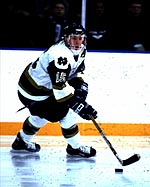 Senior right wing Brian Urick returns to captain the Irish squad. |
Three-and-a-half years later, the Irish hockey team is poised to live up the expectations, often unrealistic, that were heaped on the program’s previous squads.
“The players on this team have been through the battles and have begun to set a standard for Notre Dame hockey,” said Poulin. “This team has felt many emotions. Losing by wide margins. Losing too many close games. Troubles on special teams. Failing to take care of home ice. All of those things have been beneficial and the pieces are in place for success. We have uncertainties, as does every team, but our coaching staff believes in the character of these players. They’re ready to go.”
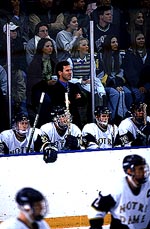 |
| Dave Poulin enters his fourth season at the helm of the Irish. |
By accepting Notre Dame’s offer in April of ’95, Poulin walked away from a 12-year National Hockey League career that included three Stanley Cup Finals appearances and a seven-year stint as the Philadelphia Flyers team captain. Years earlier, he had led Notre Dame to the ’82 Central Collegiate Hockey Association title game, the closest the program ever has come to the NCAAs.
Thus it was only natural for heightened expectations to accompany the hiring of Poulin, a classic overachiever who had a thorough appreciation for the importance of hard work and strong leadership.
Despite those expectations, Poulin cautioned patience. “The quick way is not always the right way. This is not a ‘band-aid’ situation,” he said. “Hard work is at the core of everything we do and we want this to be an encompassing experience that also develops players’ off-ice character.
“On the ice, through, we simply want to win. Our goal is to win a national title and I’m confident that will happen. We’re not content just being a good team.”
Such a lofty goal is all the more noteworthy due to the fact that the program nearly was disbanded in 1983, reverting to club status before returning as a non-scholarship independent for eight seasons. The program returned to the CCHA and scholarship status, in 1992-93, but that first season yielded just a 10th-place finish, followed by eighth and ninth-place campaigns.
Poulin met the challenge with enthusiasm but his first two teams placed 10th. Still, changes were afoot, led by the infusion of highly-regarded recruiting classes, and the Irish showed marked improvement in 1997-98 by tying for sixth in the CCHA before giving eventual NCAA champion Michigan a major scare in the CCHA playoffs.
If the third year of the Poulin era was the season to expect the greatest jump in the standings, then the upcoming fourth season is centered on developing consistency for an upper-division finish in the CCHA.
A common thread in the Poulin era has been the abstract concept of learning how to win. As one of the nation’s few programs that routinely signs 18-year-olds, Notre Dame had the nation’s second-youngest average age in ’96-’97 and third-youngest last season. It’s that sort of reliance on building young talent that has extended the transition to being a winning program.
“Young players take time to adjust,” said Poulin, whose squad is set to return 22 of 27 players, including five of the top six scorers and eight defensemen. “We’ve relied on those young players for important roles, but experience will bring consistency.”
Despite the addition of 18 freshmen to the Irish hockey program for the ’96-’97 and ’97-’98 seasons, several veterans shouldered important roles. Most notably, goaltender and 1998 graduate Matt Eisler earned three team MVP honors in his stellar career.
Just how the Irish respond in the post-Eisler era could play a major role in determining the team’s success in 1998-99, with current senior Forrest Karr serving as the leading candidate to be stationed between the pipes when the season opens with the Oct. 3 Hall of Fame Game at the University of Wisconsin.
“Matt was our anchor and played a huge part in the program’s transition,” said Poulin. “Over the past six years, this program has gone from no scholarships to contending on the national level. It’s no coincidence that Matt was in the net four of those years.”
Poulin’s 9-23-4 first season included victories over nationally-ranked Lake Superior State and Wisconsin, wins that may have taken away focus. “When you are young, the wins can become too special. We didn’t know how to react, didn’t continue doing the things that are necessary to win,” said Poulin. “But we’re at the point now where we can compete with anyone on a night-to-night basis. And that’s a crucial distinction.”
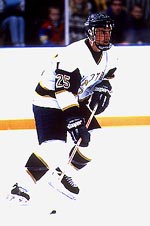 |
| Senior defenseman Benoit Cotnoir. |
While MVP Jamie Ling led the ’95-’96 team in scoring, the Irish received a boost from three freshmen who now are the leaders of the senior class – left wing Aniket Dhadphale, right wing Brian Urick and defenseman Benoit Cotnoir.
A year later, the Irish welcomed a talented class, led by center Ben Simon, right wing Joe Dusbabek and defensemen Nathan Borega and Tyson Fraser. The squad was noticeably young, with more freshmen (10) than juniors (three) and seniors (five) combined, and the program failed to improve on its win total, going 9-25-1. The season’s theme clearly was one-goal losses, as the Irish came out on the short end of 12 one-goal games and won just three, with three losses in the final minute.
“Those losses showed we were competing, but we weren’t finding a way to win,” said Poulin. “Instead, we were finding a way to lose. Those lessons may be the most important ones this program ever experiences.”
The summer of 1997 produced a special moment, as Simon, Dusbabek and incoming freshmen Jay Kopischke and Ryan Clark were selected in the NHL draft, tying Boston College for most from any one school. “That showed the caliber of players we are recruiting, with the credit going to our assistant coaches, who combine tireless recruiting with a knowledge of what type of individual will succeed at Notre Dame,” said Poulin.
An improved power play and more offensive weapons helped Notre Dame double its win total in ’97-’98 (18-19-4). The Irish also showed great character in hostile arenas, posting wins at St. Cloud State (twice), Michigan State, Wisconsin and Northern Michigan. That confident road play returned at Michigan in the CCHA playoffs, as the Irish nearly became the first team seeded seventh or lower to advance to the semifinals. Eisler’s brilliant play highlighted the opening 4-2 win and Notre Dame led 1-0 the next night before seeing Michigan win 2-1 in the 19th minute of overtime. The Irish jumped ahead 2-0 in the final game, only to lose 4-3, but the hockey world had taken notice.
Several honors followed, led by defenseman Mark Eaton-who went on to sign as a free agent with the Philadelphia Flyers-capturing CCHA rookie of the year. Noble, the program’s only three-year captain, graduated with a 3.96 cumulative GPA while earning first team Academic All-America honors and finishing as runner-up for the national Hockey Humanitarian Award. Four players-Cotnoir, Dhadphale, Simon and Eaton-were named to the honorable mention All-CCHA team.
But as the Irish stare down the barrel of the ’98-’99 season, they know that veteran forwards such as Dhadphale, Simon and Urick will be relied on for strong seasons, as will surging sophomore left wing Dan Carlson. Highly-regarded freshman centers David Inman and Brett Henning-a member of the USA under-18 national team program-will look to help fill the void left by Noble and fellow graduate Lyle Andrusiak. Several others with have the chance to elevate their games, with that group including senior Craig Hagkull, juniors Troy Bagne and John Dwyer and promising sophomores Chad Chipchase, Ryan Dolder, Matt Van Arkel and Kopischke.
Urick (Minnetonka, Minn.) returns to captain the Irish, after serving as an alternate in his junior season, and could be due for a breakout year after ranking first or second on the team in scoring his first three seasons (26 points in ’95-’96, 25 in ’96-’97, 34 last season). It’s that type of consistency, and a penchant for big plays, that has made Urick a special leader for Notre Dame hockey.
“Brian has developed into a great hockey player, but he still could surprise people with what he’s capable of,” said Poulin, who saw the current Irish captain score four goals at Alaska Fairbanks in the first CCHA game of the Poulin era and the first of Urick’s career.
“He has skated a lot of shifts and has made tremendous strides in poise and control. He’ll do a great job leading this team and deserves a memorable final year, after all the hard work he has put into the process.”
Urick is joined on the attack by his classmate Dhadphale (Marquette, Mich.), who has rapidly become one of the most feared snipers in college hockey. As a junior, he lit the lamp 25 times, with 12 of those goals coming on the rejuvenated Irish power play.
Among the CCHA’s returning players, only Michigan State’s Mike York (27) and Ohio State’s Eric Meloche (26) scored more goals in 1996-97 than the Irish sniper, while his dozen power-play goals qualify Dhadphale as the nation’s third-highest returning man-up scorer (Air Force’s Justin Kieffer had 14 while York finished with 13).
“Aniket is obviously a classic goalscorer, but his overall game also continues to improve,” said Poulin, not intending to sell short his sharpshooter’s primary role. “Aniket is the type of individual who leads by his play and we will need him to set the tone for us offensively.”
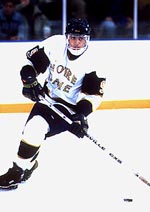 |
| Senior left winger Aniket Dhadphale. |
Dhadphale’s journey has been an interesting one. He led the Irish with 13 goals as a freshman before managing just five scores in his second campaign. During that frustrating ’96-’97 season, he averaged 22 shots per goal. But things changed for the better in ’97-’98, when he needed only 5.4 shots for every goal he produced. Such efficiency remains the simple goal in ’98-’99.
Unlike his senior counterparts, Simon (Shaker Heights, Ohio) has yet to reach his goal-scoring potential, despite an undeniable ability as a playmaker that has produced 47 assists and countless highlight clips in his first 67 games with the Irish.
His near-misses have resulted in Simon failing to reach 10 goals in each of his first two seasons (four as a freshman, nine last season) while averaging nearly 14 shots per goal during that span. This from a player who totaled 166 goals in four prep seasons, including 45 goals in 50 games as a member of the Cleveland Junior Barons in 1995-96.
“Ben is a great example of a player who has to develop within his own parameters,” said Poulin. “He’s become a much better all-around player, has improved his defense, is learning to use his teammates better on the ice and has matured off the ice.”
Simon-who led the Irish in scoring last season (9G-28A)-took a brief break from the Irish program during the past two years, in order to help represent the United States at the World Junior Championship, and in both seasons he seemed to lack the continuity that was so apparent during his prep days. Possibly the most glaring evidence of that fact was that he managed just two goals, on 57 shots, in the 19 games after returning from the ’97-’98 World Juniors.
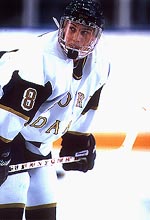 |
| Junior center Ben Simon. |
“In many ways, Ben is still learning to play hockey and it takes time for him to absorb certain things,” said Poulin, who may bring back the line of Dhadphale-Simon-Urick that the Irish used during the final month last season. “It’s critical that he’s willing to learn and take the good times with the frustrating ones.
“In Ben’s case, it’s a process that can’t be accelerated. But people better watch out when he starts hitting his stride.”
While the above three players are the established leaders of the offense, several others will look to build on their past performances.
One of the most intriguing cases is Dusbabek (Faribault, Minn.), who shared the 1996-97 Irish scoring lead with Urick-both had 13 goals, 12 assists-while finishing as runner-up for CCHA rookie of the year. Sophomore slump may have been an understatement for the gritty power forward during the first 21 games of ’97-’98, when Dusbabek scored just once on 41 shots while providing nine assists, several of them at key junctures. He joined his roommate Simon as fellow forwards on the 22-man United States roster at the World Junior Championship, ringing in the new year in Switzerland while the Irish were doing battle back home. But there would be no resumption of the season for the second-year right wing, who took a break from competition in the spring of ’98 in order to focus on his academics.
“Joe had a tough sophomore year-he’ll be the first to tell you that-but he also is a young man of tremendous character who cares a lot about this program and wants to do his part to see it succeed,” said Poulin. “College is all about maturing in many different areas, and Joe has grown a lot over the past year. He’ll be ready to go and we’re excited to see what type of role he will play for us this season.”
Another of Notre Dame’s 10 Minnesota natives, Carlson (Edina, Minn.) embarks on his own sophomore season after surpassing Dusbabek’s rookie point total, thanks to 11 goals and 17 assists in ’97-’98. With the rare combination of being one of the quickest forwards in the CCHA and one of the strongest players on the Irish squad-in spite of his 5-10 frame-Carlson is poised to keep on chugging in 1998-99.
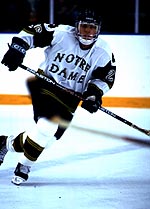 |
| Sophomore left winger Dan Carlson. |
“Dan joined us right out of high school and it took him until midseason to get acclimated to college hockey,” said Poulin of Carlson, who along with Henning could end up on the ’98-’99 edition of the U.S. world junior team.
“We gave Dan a lot of responsibility, in areas such as handling point on the power play, and he played an important role in our success. The key to his development will be knowing when to be quick and identifying the proper times to use his assets. He’s going to be a great player in the CCHA.”
The remaining eight veteran forwards each totaled 11 points or fewer a year ago and provide diverse abilities to the front line. Hagkull (Arden Hills, Minn.) has 86 career games under his belt and could prove valuable as one of just three returning centers on the current squad. The hard-hitting Dwyer (Winnetka, Minn.) was a pleasant surprise last season, with six goals and four assists from the right wing. Another junior, Bagne (Moorhead, Minn.) has great versatility and will be looking to boost his offensive production.
Carlson’s fellow sophomore forwards are poised to make the type of contributions that characterized their classmate’s first season. Van Arkel (Richton Park, Ill.) was the top scorer among that group, with five goals and six assists from the right wing, and will be looking to combine his speed on the ice with the lessons learned from an up-and-down ’97-’98 season. Chipchase (Clinton, Ont.), who stacks up as one of the squad’s top defensive forwards and most conscientious workers, could be shifted to center after totaling five goals and three assists from the wings a year ago.
Kopischke (Alexandria, Minn.) managed just two goals and four assists as a freshman, but the 6-3, 215-pound left wing could put on a sophomore surge by displaying the combination of size, speed and scoring touch that made him an eighth-round draft pick of the Los Angeles Kings. One player who didn’t want the ’97-’98 season to end was Dolder (Hutchinson, Minn.), a scrappy right wing whose two playoff goals at Michigan-one a game-winner-doubled his regular-season output.
Henning (Huntington, N.Y.)-son of former N.Y. Islanders great and current Islanders associate head coach Lorne Henning-ranked seventh in scoring (13 goals, 31 assists) among 28 forwards on the U.S. national under-18 team that trained throughout ’97-’98. Known for his intelligent play and strong all-around skills, Henning also should show a boost in his strength and skating ability after the year-long regimen with the national program.
Inman (Toronto, Ont.) is known for his smooth playmaking and vision on the ice, with his recent accomplishments including helping Team Ontario capture the under-17 World Hockey Challenge gold medal before posting a 51-goal, 53-assist season in 53 games with the Wexford (Ont.) Raiders.
Freshman Mike Vossen (Burnsville, Minn.) rounds out the forward unit, as a late addition and the eighth Minnesota native among the ’98-’99 Irish forwards.
Notre Dame headed into the last week of January, 1998 knowing that just over a month remained in the regular season while also knowing that the future looked bright for its defensive corps, which would be losing Eisler but was set to return all nine of its defensemen.
But then, things began to happen.
Just two weeks later, Fraser (Surrey, B.C.)-a subtle talent and one of the team’s most intelligent players on the ice-began to sit out with back problems. He ultimately missed the final 12 games of ’97-’98-with his status remaining uncertain for ’98-’99.
Meanwhile, Karr had pieced together several strong outings as Eisler’s backup-posting a 1.45 goals-against average and a 5-1-1 record during his first seven starts-but he went closed the season by giving up single-game totals of four, seven and five goals in his final three games.
Most recently, Eaton-who somehow went undrafted as an 18 and 19-year old-announced on July 28 that he was foregoing his eligibility after signing with the Flyers as a free agent.
Suddenly, an area of few concerns now stands as possibly the most pivotal aspect of the 1998-99 squad.
“Our ability to play consistent defense-as a team and as individuals-will be a huge key this season,” said Poulin. “We have pieced together two strong penalty-killing seasons and have worked hard to lower our goals against. We still have some healthy and experienced veterans to lead the way. Beyond that, some other players may have to step forward and answer the bell-which they are certainly capable of doing.”
The hard-hitting but disciplined Borega, who had just 16 penalties in 34 games last season, returns with his 6-2, 225-pound frame to anchor the defense, as does the physical presence of the 6-4, 225-pound Clark, who had six assists as a rookie while totaling just 11 penalties.
The Irish also welcome back the dangerous two-way play of Cotnoir, in addition to senior Scott Giuliani and juniors Sean Molina, Andy Jurkowski and Sean Seyferth. The lone newcomer, 6-0, 205-pound Sam Cornelius, will join what could be one of top groups of defensemen at Notre Dame since the early ’80s.
Cotnoir (Rouyn-Noranda, Quebec) had a fulfilling junior season, in which he showed overall consistency and a reliance on simple plays-both of which were lacking in his more erratic and mistake-prone first two seasons. As the top returning goalscorer among CCHA defensemen, Cotnoir’s value as a senior again should be at both ends of the ice. “Benoit helps make our offense go, particularly on the power play, and he has made some huge strides in his all-around game. He has really developed into an excellent leader for this team, which is great to see,” said Poulin.
Borega (Wasilla, Alaska) has the reputation as one of the CCHA’s most physical defensemen but also fits into the team’s goal of playing with intelligence and poise. “Nathan is a warrior who epitomizes what this program has been through and where it’s going,” says Poulin. “He gives new definition to the term setting the tone on defense and should be in for a great year.”
Clark (Littleton, Colo.), who formed an imposing duo skating alongside Borega in the playoff series at Michigan, was a quiet force as a freshman while his hits and big plays began to pile up. “Ryan is a very physical player and will play an important role helping to defend our goal-we’re expecting a great season from him,” said Poulin.
The first two seasons for Molina (Skokie, Ill.) have been solid but unspectacular-particularly on the offensive end, where he has yet to score a goal while totaling eight assists. But following the loss of Eaton and the uncertainty with Fraser, Molina could have the chance to make his mark with the 1998-99 Irish defensive unit.
Jurkowski (Madison, Wis.) has pulled double duty at left wing and defense but will open his junior season as one of the eight veteran blueliners. Seyferth (Ann Arbor, Mich.) played just seven games in ’97-’98 but has seen time in crucial situations during his first two seasons. Like many of the above players, Giuliani (Burlington, Ont.)-who has logged just 17 career games-also will be looking to raise his play during his last season.
Cornelius (Edina, Minn.), a prep teammate of Carlson’s on Edina High School’s 1997 state championship squad, should help the cause due to his strong skating, physical play and ability to contribute on the offensive end (he had 34 points in 24 games as a senior).
A primary question for ’98-’99 is how Karr will react to the possibility of starting, after a solid junior season that included a 6-3-1 record and a 2.85 goals-against average. “K” seems to be the magic letter in the Irish nets this season, as sophomore Kyle Kolquist (Duluth, Minn.) and freshman Jeremiah Kimento (Palos Hills, Ill.) will compete with Karr for time between the pipes.
“A strong start would be nice for Forrest, but ultimately consistency and his mental approach will be the most crucial,” said Poulin, one of several CCHA coaches looking to replace a starting goalie. “Forrest has won some big games, and Kyle and Jeremiah certainly are capable of stepping up. Again, the true test will be in the areas of mental toughness and consistency.”
As Poulin takes a final look ahead to the rapidly approaching season, he points to several promising signs – both on and off the ice. The Irish were the CCHA’s least-penalized team the past two seasons, which “says a lot when you look at how physical we are and how hard we compete,” he said. “That discipline is necessary to win. You might not think it transfers over … but it does.”
Off the ice, the team sponsors a popular fall race to help fight cancer and posted a 3.2 team GPA in the spring of ’98. “That’s significant, when you look at the classes these guys take and the fact that the team is 27 players,” said Poulin. “We’re trying to run a complete program in every sense of the word, and to do that you need a consistency in effort. We continue to take the needed steps and are happy with how things are progressing.”
Nobody ever said learning how to win would be easy.






